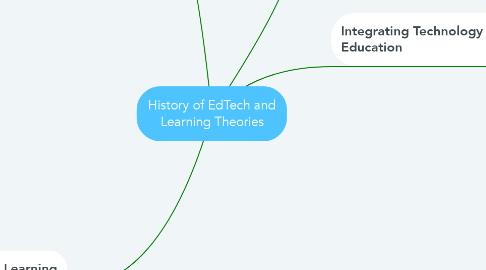
1. Main Idea: The correlation between students capability and quality of learning within education is influenced by the form of instruction used to teach the curriculum and overall behaviors
2. Theories of Learning
2.1. Behaviorism
2.1.1. Classical Conditioning
2.1.2. Operant Conditioning
2.1.2.1. Rewards and Punishments
2.1.2.2. Positive and Negative Reinforcements and Consequences
2.2. Direct Instruction (Programmed instruction)
2.2.1. Teacher-centered learning
2.2.2. Teacher-defined goals
2.2.3. Changing a students behaviour
2.3. Jean Piaget's Theory of ConstructiVism
2.3.1. learner construct/build their own knowledge progressively through experiences
2.3.1.1. Sensorimotor
2.3.1.2. Preoperational
2.3.1.3. Concrete Operational
2.3.1.4. Formal Operational
2.3.2. Constructivism
2.3.2.1. Individual learning to build internal knowledge representations through processes
2.3.2.1.1. Assimilation
2.3.2.1.2. Accommodation
2.4. Vygotsky: Social Constructivism
2.4.1. collective
2.4.2. idea of co-construction of knowledge through interaction with others
2.4.3. social context is key
2.4.4. Thinking and language development overlapping as one ages
2.4.5. The Zone Proximal Development
2.5. Bruner (building from Piaget) Constructivism
2.5.1. from concrete to abstract thinking when learning
2.5.1.1. Enactive
2.5.1.2. Iconic
2.5.1.3. Symbolic
2.5.2. Spiral Curriculum
2.5.3. Discovery Learning
2.5.3.1. learner draws on past experiences and existing knowledge to discover new facts and relationships
2.6. Constructionism
2.6.1. when the learner is engaged in the construction of something external
2.6.2. Pillars of Constructionism
2.6.2.1. Designing meaningful projects in social setting
2.6.2.2. powerful ideas empower and motivate the learner
2.6.2.3. creation of tangible artifacts using objects
2.6.2.4. reflection and refining artifacts through social interaction
3. The Relationship between Integrating Technologies into Education and Learning Theories
4. Integrating Technology Into Education
4.1. Learning ABOUT Technology
4.1.1. How and why things work
4.1.2. Maker movement in education
4.1.2.1. drones, robots, 3D printer, computational thinking
4.2. Learning WITH Technology
4.2.1. Mindtools
4.2.1.1. support and enhance problem solving, critical thinking
4.2.1.2. engagement, control
4.3. Learning FROM Technology
4.3.1. Main Ideas
4.3.1.1. Computer-Assisted Instruction
4.3.1.1.1. computer-based training
4.3.1.2. Teaching Machines
4.3.1.2.1. drill and practice
4.3.1.2.2. tutorial
4.3.1.2.3. primitive instructional games and simulations
4.3.1.3. Intelligent Tutoring Systems
4.3.1.3.1. advanced simulation, problem solving, tutoring
4.3.2. Teaching Machines Throughout History
4.3.2.1. Sidney Pressey's Teaching Machine 1920's
4.3.2.1.1. Behaviorism
4.3.2.1.2. LaZerte's Problem Cylinder 1930
4.3.2.2. B.F Skinner's Teaching Machine 1954
4.3.2.2.1. Underlying learning theory of behaviorism
4.3.2.2.2. Key Ideas
4.3.2.3. PLATO 1960 (Programmed Logic Automated Teaching Operation)
4.3.2.3.1. TUTOR language
4.3.2.3.2. Innovations
4.3.2.4. International Business Machines (IBM) 1966
4.3.2.4.1. Computer Assisted Instruction (CAI)
4.3.2.4.2. Delivering Instruction
4.3.2.5. Digital Equipment Corporation
4.3.2.5.1. Challenges
4.3.3. Challenges
4.3.3.1. cost to develop quality material
4.3.3.2. limited lifespan of technology
4.3.3.3. level of knowledge needed to program
4.3.3.4. environments not structured to support

